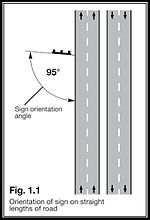On a straight length of road the horizontal axis of a sign should be set at an angle of 95° away from the general alignment of the left side edge of carriageway on the approach side (see fig. 1.1). On some bends and complicated winding alignments, compromise solutions may have to be adopted but generally it will be adequate on a right-hand bend for a sign to be set at an angle of 900 to a line tangential to the left-hand edge of the carriageway at the point where the sign is erected (fig. 1.2). Signs sited on left-hand bends should be set at an angle of 95° measured clockwise from a line joining the edge of the carriageway at the sign with a point on the same edge of carriageway 200 metres in advance of the sign (fig. 1.3).
1.52 Signs are normally to be set transverse to the line of travel of approaching road users. The main exceptions to this are the plates detailing the hours of waiting restrictions, which should be parallel to the kerb and some direction signs because they must point approximately to the direction to be taken.
1.53 For speed limits and traffic regulation Orders terminal signs will have to be placed at the ends of the lengths of road to which the Orders apply. As the signs must be obeyed they must be placed in a position of good visibility. It follows therefore that the lengths of restrictions themselves may be influenced by the best sign positions and before Orders are made due consideration should be given to the precise siting of terminal signs. This should not be done in such a manner that appreciable lengths of unnecessary restrictions result.
1.54 In siting signs the advice given in subsequent chapters should be closely followed although it will not always be possible to adhere precisely to these standards due to site limitations. Variations in distance of up to 10% are generally permissible, but if an appreciably greater variation seems required other alternatives should first be investigated. Steps should be taken to deal with obstructions to the visibility of signs. Over-hanging trees and shrubs should be cut back and bus stops moved if necessary. Standing vehicles may have to be prohibited if the sign cannot be sited to be free from such obstruction.
1.55 Permanent features which cannot be altered such as bends, hill crests, narrow verges, buildings etc will necessitate the special siting of signs. It is preferable to increase the standard distance between the sign and the site to which it relates rather than diminish it, but such increase should not be more than the 10% tolerance mentioned in paragraph 1.54. If a suitable site cannot be found within these tolerances, then a decrease should be investigated. Terminal signs should be placed at or as close as practicable to the point specified in the relevant Order.
1.56 At all times correct visibility distances of the sign should be maintained. It is particularly important to ensure that growing vegetation, subsequent building development and other features such as shop signs and blinds do not obscure road signs.



